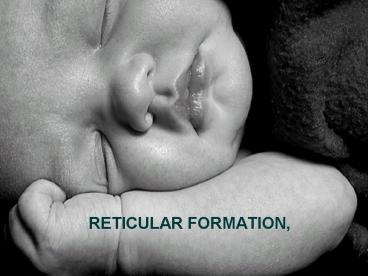RETICULAR FORMATION, - PowerPoint PPT Presentation
1 / 7
Title:
RETICULAR FORMATION,
Description:
RETICULAR FORMATION, RETICULAR FORMATION Diffuse mass of neurons & nerve fibers that make the core of the brain stem; They run through the medulla oblongata, pons ... – PowerPoint PPT presentation
Number of Views:731
Avg rating:3.0/5.0
Title: RETICULAR FORMATION,
1
RETICULAR FORMATION,
2
RETICULAR FORMATION
- Diffuse mass of neurons nerve fibers that make
the core of the brain stem - They run through the medulla oblongata, pons
midbrain
- Nc. of medullary reticular formation
- Nc. of pontine reticular formation
- Nc. of midbrain reticular formation
3
RETICULAR FORMATION AFFERENT EFFERENT
CONNECTIONS OF RETICULAR FORMATION
Optic, auditory olfactory and taste pathways
Sensory Pathways
Cerebellum
Substancia Nigra
Thalamus
Cortex
Reticular Formation
Red Nucleus
Reticular Formation
Cortex
Cerebellum
SC
SC
Tectum
(Touch, pain, temperature, kinesthestic
sensation)
Thalamus, Hypothalamus
Corpus Striatum
EFFERENT CONNECTION TO THE RETICULAR FORMATION
AFFERENT CONNECTION TO THE RETICULAR FORMATION
4
FUNCTIONAL DIVISIONS OF RETICULAR FORMATION
RETICULAR ACTIVATION SYSTEM (RAS)
Name given to
RETICULAR FORMATION ITS CONNECTIONS
Its believed to be the center of arousal and
motivation in mammals (including humans).
ASCENDING RETICULAR ACTIVATION SYSTEM
DESCENDING RETICULAR ACTIVATION SYSTEM
5
ASCENDING RETICULAR ACTIVATION SYSTEM - ARAS
- Receives fibers from the sensory pathways via
long ascending spinal tracts. - Alertness, maintenance of attention and
wakefulness. - Emotional reactions, important in learning
processes. - Tumor or lession sleeping sickness or coma.
6
DESCENDING RETICULAR ACTIVATION SYSTEM - DRAS
- INHIBITORY
- Smoothness and accuracy of voluntary movements
- Reflex movements
- Regulates muscle tone
- Maintenance of posture
- Control of vegetative functions.
- FACILITATORY
- Maintains the muscle tone
- Facilitates autonomic functions
- Activates ARAS.
7
RETICULAR FORMATION FUNCTIONS
- REGULATION OF SLEEP, thus, the maintenance of the
SLEEPING cycle or CIRCADIAN rhythm - Filtering of incoming stimuli to discriminate
irrelevant background stimuli - Its crucial to maintain the state of
CONSCIOUSNESS related to the circadian rhythm
MELATONIN effects on RAS - ANS control respiratory rate, heart rate, GIT
activity.

